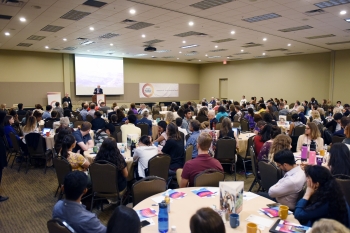With organizations the caliber of Mayo Clinic, TGen, the Flinn Foundation, Arizona BioIndustry Association and the state’s universities, Arizona boasts a multitude of talented scientists, health professionals, life science entrepreneurs, nonprofits and government leaders committed to contributing to the quality of life in our state. Arizona’s bioscience sector is adding jobs at a rate that outpaces the nation. And its public universities are seeing increases in bioscience research funding, expenditures and tech transfer.
But for more than 300 people who came together last week for the Arizona Wellbeing Commons, that’s just not good enough. Created three years ago, the commons is all about making connections. More than 300 people from Arizona’s health and bioscience-related organizations convened Sept. 27 for the annual Arizona Wellbeing Commons conference.Download Full Image
More than 300 people from Arizona’s health and bioscience-related organizations convened Sept. 27 for the annual Arizona Wellbeing Commons conference.Download Full Image
“Historically, the biological sciences were studied in individual labs, each using its own particular expertise,” said Joshua LaBaer, leader of the commons and executive director of the Biodesign Institute at Arizona State University. “And that approach is fine if the goal is discovery alone. But we want to go beyond discovery to implement these discoveries into practices that have impact. Real-world impact is a higher bar that requires input from many dimensions and a team approach. This is an opportunity to build these teams — to learn about what’s happening outside our own walls and discover new ways to put our resources together to address the health and medical challenges of our community more expediently and efficiently.”
According to group leaders, the organization serves as “an umbrella group that facilitates the development of strong working partnerships to create new opportunity, build capacity and grow influence in Arizona.”
“I am inspired by this conference,” said Larry Penley, chair of the Arizona Board of Regents. “Together, you are a powerful network and your collaboration is applauded by the board.
“Because of this new ‘innovation economy,’ the Arizona Board of Regents has structured its budget requests to the state this year around this very issue; around a workforce that comes from the sciences, engineering, biomedicine and allied health; around the state’s capacity to match major university research grant proposals that will drive new ideas and new businesses in our economy.”
Penley noted his enthusiasm for the new Phoenix Biomedical Campus, a 30-acre medical and bioscience campus that will bring together the resources of ASU, the University of Arizona, Northern Arizona University, TGen, Flinn Foundation, the city of Phoenix and the Arizona BioIndustry Association.
“Not only will we be able to expand the availability of biomedical degrees, but also accelerate biomedical research and translation of those new ideas into new technologies that will drive our community forward,” Penley said.
Keynote speaker Alan Leshner, interim CEO of the American Association for the Advancement of Science and the executive publisher of the Science family of journals, discussed the globalization of science and emphasized the need for multidisciplinary solutions. He proposed that revolutionizing the structure of our graduate education and funding strategies is important to achieving a multidisciplinary mindset.
“Multidisciplinary science is the leading edge in discovery,” he said.
David Sklar, an emergency room physician and senior adviser and professor in ASU’s College of Health Solutions, shared his concerns about pedestrian deaths in Arizona, noting that Arizona has the highest rate of pedestrian fatalities in the nation. A review of factors contributing to this public health challenge — road conditions, alcoholism, speed, pedestrian walkways and emergency response — indicate that solutions to the problem will require a multidimensional effort.
Recognizing both the issues we face and the intellectual capital we have here in Arizona, the commons is organized in seven divisions, attracting those most interested in addressing specific issues:
- Cancer prevention, detection, management and treatment.
- Public health and health care services law, policy and equity.
- Nutrition, obesity, exercise and lifestyle.
- Viruses, immunity, microbiomes and infectious diseases.
- Mental health, substance abuse, crime and behavior change.
- Neurobiology, aging, dementias and movement disorders.
- Culture, arts, design and humanities in health.
The culture, arts, design and humanities in health division was added this year. Tamara Underiner, associate dean for academic affairs in ASU’s Graduate College and associate professor in the School of Film, Dance and Theatre, welcomed a standing room-only crowd, explaining that although our nation spends more on health care than most countries, we still suffer lower life expectancy and higher mortality and disease burden rates. She said that adding elements of art and culture to health care programs can alleviate this disparity, citing cases where art has cured chronic depression and how introducing music to care homes has improved mental health among patients and their caregivers.
“These are just some of the things that happen when you add heart and art,” Underiner said. “It shows real vision on the part of the commons’ organizers to recognize out loud the key role culture plays in health and well-being for all Arizonans,” she added. “Finding ways to collaborate with and across the divisions will help us develop more holistic approaches to some of the biggest challenges we face.”
“I came to Arizona about the same time the Flinn Foundation started the Biosciences Roadmap,” said Jennifer Barton, director of Bio5 at University of Arizona. “I remember coming to my first Flinn meeting as a young assistant professor and thinking, ‘I’ve come to the right place. And now, some 18 years later, we’ve shown how that collaborative gene is important, and the Wellbeing Commons is a great way to bring everyone together and create tangible outcomes.”
Written by Dianne Price and Gabrielle Hirneise

